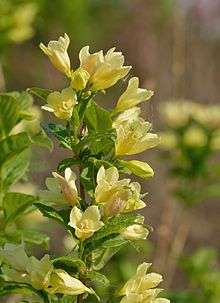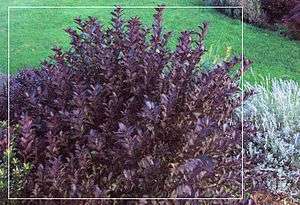Weigela
| Weigela | |
|---|---|
 | |
| Weigela florida | |
| Scientific classification | |
| Kingdom: | Plantae |
| (unranked): | Angiosperms |
| (unranked): | Eudicots |
| (unranked): | Asterids |
| Order: | Dipsacales |
| Family: | Caprifoliaceae |
| Genus: | Weigela Thunb.[1] |
| Species | |
|
See text | |
Weigela /waɪˈdʒiːlə/[2] is a genus of between six and 38 species[3] of deciduous shrubs in the family Caprifoliaceae, growing to 1–5 m (3-15') tall. All are natives of eastern Asia. The genus is named after the German scientist Christian Ehrenfried Weigel.[4]
Description
The leaves are 5–15 cm long, ovate-oblong with an acuminate tip, and with a serrated margin.
The flowers are 2–4 cm long, with a five-lobed white, pink, or red (rarely yellow) corolla, produced in small corymbs of several together in early summer.
The fruit is a dry capsule containing numerous small winged seeds.
Garden history
The first species to be collected for Western gardens, Weigela florida, distributed in North China, Korea and Manchuria, was found by Robert Fortune and imported to England in 1845.[4] Following the opening of Japan to Westerners, several Weigela species and garden versions were "discovered" by European plant-hunters in the 1850s and 1860s, though they may have already been known to locals.[5]
The British Weigela national collection is held at Sheffield Botanical Gardens; along with the national collection of the closely related Diervilla genus.[4] The German Weigela national collection, Sichtungsgarten Weigela, is in Buckow, Maerkische-Schweiz.[6]
Ecology
Weigela species are used as food plants by the larvae of some Lepidoptera species including brown-tail.
Selected species

- Weigela decora (Nakai) Nakai
- Weigela florida (Bunge) A.DC.
- Weigela grandiflora (Siebold & Zucc.) Fortune
- Weigela hortensis (Siebold & Zucc.) K.Koch
- Weigela japonica Thunb. (type)
- Weigela praecox (Lemoine) Bailey
- Weigela sanguinea (Nakai) Nakai
- List source :[3]
Cultivation
Several of the species are very popular ornamental shrubs in gardens, although species have been mostly superseded by hybrids (crosses between W. florida and other Asiatic species). The following cultivars have gained the Royal Horticultural Society's Award of Garden Merit:-
- W. florida 'Foliis purpureis'
- W. florida 'Variegata'
- W. praecox 'Variegata'

References
- ↑ The genus Weigela and the type W. japonica were originally described and published in Kongl. Vetenskaps Academiens Nya Handlingar 1: 137, pl. 5. 1780[1781]. "Name - !Weigela Thunb.". Tropicos. Saint Louis, Missouri: Missouri Botanical Garden. Retrieved December 2, 2012.
Type Specimens: T: Weigela japonica Thunb.
- ↑ Sunset Western Garden Book, 1995:606–607
- 1 2 All of the species listed in the 'Selected species' section are accepted by The Plant List, but most are still under review, and therefore subject to changes in status. "TPL, treatment of Weigela". The Plant List; Version 1. (published on the internet). Royal Botanic Gardens, Kew and Missouri Botanical Garden. 2010. Retrieved December 2, 2012.
- 1 2 3 "Sheffield Botanical Gardens Weigela". Sheffield Botanical Gardens Trust. November 26, 2008. Retrieved December 2, 2012.
- ↑ Mark Nesbitt, The Cultural History of Plants, 2005:284; Ran Levy-Yamamori, Ran Levy, Gerard Taaffe, Garden plants of Japan, 2004, s.v. "Weigela hortensis"
- ↑ "Weigela Sichtungsgarten" (in German). Maerkische-Schweiz. Retrieved December 2, 2012.
- ↑ "RHS Plant selector Weigela florida 'Foliis Purpureis' AGM/RHS Gardening". Royal Horticultural Society. 2011. Retrieved December 2, 2012.
- ↑ "RHS Plant selector Weigela 'Florida Variegata' (v) AGM/RHS Gardening". Royal Horticultural Society. 2011. Retrieved December 2, 2012.
- ↑ "RHS Plant selector Weigela 'Praecox Variegata' (v) AGM/RHS Gardening". Royal Horticultural Society. 2011. Retrieved December 2, 2012.
External links
| Wikimedia Commons has media related to Weigela. |